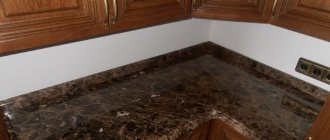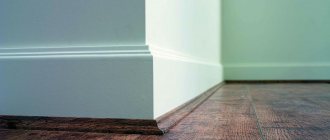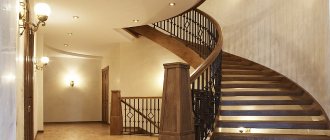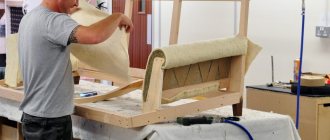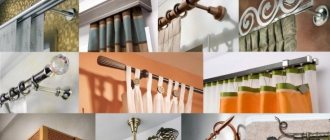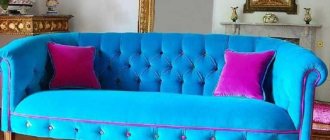The presence of baseboards has long been an integral part of room decoration. If in Soviet times this interior detail had practical properties, today the plank at the junction of the wall and floor is used to a greater extent for design.
However, according to many interior designers, decorating walls with skirting boards is rapidly losing its relevance. It is being replaced by other alternative methods of masking adjacent joints of walls and ceilings. Below we will look at the most popular, aesthetic and practical of them. Take note, perhaps one of the options will appeal to you too.
Window beads
The first place on our list is occupied by window glazing beads. This standard glass mounting option is most often made of natural wood, MDF or PVC. This range in materials allows you to select glazing beads in any price category.
You can fix glazing beads that are used instead of skirting boards using “liquid nails” or any mounting adhesive. This guarantees a reliable fit of the plank to the wall and floor and a long service life. An undoubted advantage of window glazing beads is the possibility of tinting if you do not find the desired shade.
What and how to glue floor ceramic plinths
Ceramic plinth can be attached to tile adhesive, which can be applied in a very thin layer - 1-2 mm. But it is also possible for other compositions. They are good because the layer is very thin.
- Liquid Nails.
- Any universal adhesive that is suitable for ceramics or porcelain stoneware.
Laying ceramic skirting boards with universal glue
If you are finishing the bathroom, it is very good if the glue has antifungal properties. If an antifungal agent is not found, before starting work, coat the installation site and the fragments themselves with a special compound that prevents the development of mold and other fungi. If there are any gaps and cracks, it is advisable to seal them with sealant. Also take a sealant with antifungal properties.
For sealant or glue
If the baseboard was purchased separately and not made from tiles, and it does not match the fragments in size, use glue and/or sealant. In this case, the task is to join the planks as tightly as possible, making the seam as less noticeable as possible.
You can mount a tiled floor plinth either using universal glue (such as liquid nails) or using tile
Start from one of the corners. First they make a corner. If there is no special corner, cut two planks at the desired angle and grind the cut. The smaller the gap, the better. When installing a plinth, it is necessary to degrease the cut area and then coat it with glue. It may also be necessary to apply sealant over the joint after the glue has dried. As we have already said, we take it with antibacterial properties so that it does not turn black later. Color: transparent or white. See what will be better here.
If you sit on tile adhesive, make sure that the seams are the same size and match the seams on the floor
Having filed the planks at an angle, we assemble those adjacent to them. We match the fragments of the ceramic plinth one to another. The selection criterion is color (there may be some differences) and tight joining at the ends. The ends of ceramic plinths are rarely ideal - this is a feature of the technology. Therefore, it is advisable to select skirting boards for at least two adjacent walls before starting work. You can do all four at once, but it’s a little more complicated.
We glue the selected fragments, following the instructions that are on each pack of glue. We do not put the last sections that will abut the corner. Again we “cut” the corner, adjust it to size, and grind it. And only after that we set the angle. And two parts at once. Otherwise, it will be difficult to design beautifully and achieve a match. Next, we select the strips again so that the seams are smaller and less noticeable.
For tile adhesive
If the baseboard is made of ceramic tiles that were laid on the floor, then it is better to lay it with tile adhesive. But just take one that can be applied in a thin layer - a couple of millimeters. You will also need crosses of the same size as when laying the tiles. They are needed to correctly maintain the width of the seam. After all, the fragments of the plinth exactly match the dimensions of the floor tiles, and the slightest deviation in the thickness of the seam or its displacement will be noticeable.
The general procedure is no different. Only when decorating the corners should you ensure that the plinth fragments are equal in size to the tiles.
Cork compensator
A cork compensator can be considered a more interesting option than window glazing beads. Most often it is used to hide the joints between laminate (or parquet) and ceramic tiles. The range of colors for cork expansion joints is quite poor, but the porous structure of this material lends itself perfectly to painting in the desired tone, close to the color of the floor covering.
The disadvantage of a cork expansion joint is its low resistance to moisture.
How to make a baseboard from ceramic tiles
The technology is simple. Strips of the required width are cut from the opposite edges of the tile. The cut is processed with sandpaper or a grinding wheel to obtain a smooth edge. The result is a border that perfectly matches the tiles in width and color. When installing it, you must maintain the same seam width and rub the seams together.
When cutting the plinth, the width of the cut strips is equal to the desired height of the plinth. It is better to immediately cut the required amount and, when grinding, achieve a complete match in height. If you cut one strip at a time, the difference may be visible. Tile cutters give an error, and ceramics can break in different ways.
You can make a floor plinth from ceramic tiles
The bad thing about this technique is that most of the tiles go to waste. Why is that? Because the edges are factory rounded, and the middle ends up with uneven edges and chips. In principle, you can buy a diamond grinding disc. By installing it on a high-speed drill, you can also sand the ends smooth. But this is a long and dusty business.
If you need to save money, you can dust yourself. Or you can find a company that has waterjet cutting (usually they do finishing or make porcelain tiles). With such equipment they will cut smoothly, without chipping. They can even chamfer the “middle” pieces. Of course, for a fee. But throwing away most of the tiles is much more expensive.
"Liquid plug"
An excellent alternative to the previous option and standard skirting boards is “liquid cork”. At its core, this product is nothing more than a sealant, so joining the floor to the wall in this way guarantees complete impermeability of moisture and dust in the cracks of the joints.
Unfortunately, the color of “liquid cork” usually has one shade, so this option is not suitable for all interiors.
Edge profile
A U- or L-shaped profile is relevant only for wooden flooring, since it must “fit” onto the edge of the board. Externally, the edging profile is very similar to the standard type of plinth; it will not be possible to hide it, so when choosing it, take this nuance into account and focus on it.
A significant advantage of the edging profile can be considered a huge variation of color solutions; this will greatly facilitate the selection of the shade of the strip for the floor covering.
conclusions
Due to the ability of laminate flooring to respond to changes in temperature, it is laid using the floating method with a technological gap around the entire perimeter of the room. This method leaves the impression of incompleteness. All joints, joints, and raw edges are clearly visible; it is easy for debris, dust, and moisture to get into the cracks.
To get out of this situation, there is a finishing plinth that can not only cover all the edges, but also enliven the interior and add bright accents to it. When choosing the type of plinth for laminate, it is necessary to take into account their combination according to several parameters.
- Baguettes made of wood or MDF will fit well on an expensive coating with imitation of natural materials.
- The right combination of laminate, baseboards, doors, furniture in color and texture will give the interior a noble look. These can be shades that are similar in tone, or contrasting colors from those that are already involved in the design of the decor.
- The dimensions of the edging depend on the dimensions of the room. For a small room with a low ceiling, a narrow, low baguette is suitable, and light shades will make it visually more spacious. Luxurious apartments with high ceilings and a classic interior style will receive a bright accent in the form of a high baseboard in a contrasting color.
There will be fewer mistakes in choosing a color in daylight, so there is no need to postpone the purchase until the evening. Installing a plinth with your own hands is easy if you choose designs with clips or decorative strips. This does not require professional skills or construction experience. Installation instructions and demonstration videos on the Internet are offered as a teaching aid.
Modern models are equipped with special channels, which are very convenient for hiding wires from household appliances and home electronics. A plinth installed in this way can be easily replaced in case of accidental damage or updating the interior design.
Ceramic border
Surely you have seen how a ceramic or glass border is used where the bathtub adjoins the wall. This is done to prevent moisture from penetrating the joints and contributing to the development of fungal mold. It is unknown who suggested using a ceramic border when decorating flooring, but this method has gained its share of popularity. The protective shell of the ceramic border has airtight properties, a neat appearance, resistance to external factors and a long service life.
If decorating the floor and walls with skirting boards has already lost its relevance for you, then stop at one of the replacement options proposed above. They have already proven their practicality and effectiveness through the personal experience of many homeowners.
New publications are published daily on our channel in Yandex.Zen
Go to Yandex.Zen.
Choosing a skirting board
The choice of flooring depends on the design project, the price of the product, and the installation method. It is not always at this moment that the thought arises that after installation is completed, it will be necessary to select a plinth for the laminate, the search criteria for which are also several.
First you need to decide what material the edging will be made of. The decision depends on the design of interior doors, window frames, and furniture. Wall decoration also needs to be taken into account. After all, the plinth harmoniously combines the vertical surface and the floor into a single space.
The practical purpose of the rooms is also important. For each type of skirting board, there are acceptable environmental conditions under which it will last for many years without repair or replacement. Wooden framing is not advisable to use in rooms with high humidity. And wood treated with moisture-repellent agents will not last long in such conditions. But plastic skirting boards feel great in the bathroom, kitchen, and toilet. They do not absorb moisture or odor and are easy to clean. But where there will be a lot of foot traffic around the house, PVC models will have to be regularly replaced with new ones.
- In a solid interior with furniture, solid wood doors and smooth walls, a wooden frame will emphasize the status of the owners. A cheaper alternative would be an MDF plinth covered with valuable wood veneer. The cost of such material is compensated by its noble appearance and long service life with good care.
- A plastic plinth will help you win in price; with it you don’t have to think about the shape of the walls. A democratic material with many shades imitates any texture, so choosing a edging to match the color of laminate or doors, windows, and furniture will not be difficult.
Another important criterion by which you choose a plinth for a laminate is the color of the finishing material. It’s good when a manufacturer produces a collection of laminated flooring along with thresholds and skirting boards. In this case, you do not need to select shades or patterns, just calculate the quantity correctly.
But more often you have to look for a laminated skirting board for a new floor among the many samples offered. In order not to get confused and make the right choice, designers advise buying laminate and edging for it in the same color scheme.
- A well-chosen baseboard color will not only look harmonious in the interior, but also create visual effects. For example, in the photo the room will seem more spacious than in reality if the laminate and baseboard are made in light colors. True, the white color is quite easily soiled and will require additional care.
- A light baseboard on a dark laminate will look original. But here you cannot do without artistic taste, because the walls will also play an important role in the color background; all shades must be combined with each other. A classic example for rooms with high ceilings is a wide white plinth, creating a solemn, elevated atmosphere.
- A room with light floors and a dark baseboard, which in its texture and color must necessarily match the furniture in the room, looks impressive.
Read about choosing the color of the laminate in the article “Dark or light laminate: choosing the color of the flooring”
The most reliable way not to make a mistake is to buy materials for laying and edging flooring from one manufacturer. Then you won’t have to think about which skirting board is better, but simply purchase all the parts in the same range of shades and with the same pattern.
An ordinary floor molding can easily implement the most daring design solutions. The texture and color can be matched to the wallpaper, doors, and window frames. There are no restrictions, just, being carried away by the choice of details, try not to lose the perception of the space of the room, turning it into a pile of heterogeneous objects.
The decorative purpose of the plinth should not overshadow its practical side. After all, the main task of finishing is to close all technological gaps and raw edges of the laminate. Therefore, another criterion by which the plinth is selected is its width. It should be enough to hide all the flaws, and, if possible, disguise wires and cables from household appliances and home electronics.
